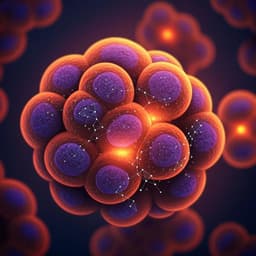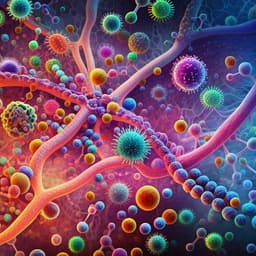
Engineering and Technology
A rapid and effective method for alloy materials design via sample data transfer machine learning
L. Jiang, Z. Zhang, et al.
Discover a groundbreaking method for alloy material design utilizing data transfer learning, as demonstrated by Lei Jiang, Zhihao Zhang, Hao Hu, Xingqun He, Huadong Fu, and Jianxin Xie. This research introduces an innovative aluminum alloy (E2 alloy) that combines ultra-strength with high toughness through a novel treatment approach, proving the potential of advanced data-driven techniques in material science.
~3 min • Beginner • English
Introduction
AA7xxx (Al-Zn-Mg-Cu) alloys are widely used in aerospace and transportation due to high specific strength and corrosion resistance, but achieving further simultaneous gains in strength and ductility is challenging. Properties depend on complex interactions among composition, solution treatment, and aging parameters, creating a vast experimental design space that makes conventional trial-and-error optimization impractical (e.g., >10 million process combinations for three-stage solution aging). Transfer learning can leverage related data to overcome small-data limitations. The authors categorize transfer learning into feature, parameter, and sample data transfer, noting prior materials applications for polymers and inorganic formation energy. In this work, they propose sample data transfer learning to rapidly optimize the heat treatment process of a newly developed E2 alloy (Al-8.9Zn-2.29Mg-1.76Cu-0.14Cr-0.1Mn-0.1Zr-0.06Ti; UTS ~700–750 MPa) by transferring 1053 composition-process-property samples from commercial AA7xxx alloys and combining them with 20 pre-experiments on E2 to build an accurate predictive model and guide multiobjective optimization for simultaneous strength and ductility improvements.
Literature Review
The paper reviews transfer learning approaches: (1) feature transfer, widely applied in vision tasks and explored for polymers by constructing features from large databases (OQMD, Materials Project) to predict new properties such as thermal conductivity; (2) parameter transfer, where parameters learned from computational datasets (e.g., DFT formation energies) are transferred to experimental datasets to improve predictions; and (3) sample data transfer, which directly trains on related-domain samples to address small-data problems. In alloy design, classical methods (first-principles, phase-field, and extensive experiments) face scalability limits as alloy systems grow more complex. Prior studies demonstrate the potential of transfer learning in materials property prediction, motivating the authors’ choice of instance-based transfer learning (TrAdaBoost) to integrate large AA7xxx datasets with limited E2 data to optimize heat treatment.
Methodology
Data and problem setup: A basic dataset (BDS) of 1053 AA7xxx samples prepared by conventional industrial methods was compiled from literature, each with composition, multi-stage solution-aging parameters, and properties (UTS, elongation). A target dataset (TDS) of 20 E2 alloy pre-experiments was generated across three heat-treatment series: T6 (n=10), T74 (n=4), and T77 (n=6). Process parameter ranges in BDS included, for example, PS 380–530 °C, PST 15–600 min, SA 20–250 °C, SAT 0.017–1800 h, etc. TDS was split 4:1 into TDS4 (training with BDS) and TDS1 (testing).
Transfer learning model: The TrAdaBoost instance-transfer algorithm was used to build predictive models for UTS and elongation δ, with features comprising composition and solution-aging parameters. Initial weights were assigned to BDS and TDS samples, and iteratively updated based on prediction errors: BDS samples with larger errors (less relevant for E2) received decreased weights; TDS samples with larger errors received increased weights to focus learning on the target domain. Model hyperparameters (number of subtrees, maximum depth) were tuned via 5-fold cross-validation on TDS4. Performance was evaluated on TDS1 using mean absolute percentage error (MAPE).
Process optimization: With the trained predictors, a multiobjective genetic algorithm (NSGA-II) was used to construct Pareto fronts for maximizing UTS and δ. NSGA-II settings included an initial population of 5000, maximum 5000 evolutions, and at most 50 candidate schemes on the front. From the Pareto front, seven heat-treatment schedules (HT1–HT7) with predicted significant improvements over T6 were selected for experimental validation. A comparative hybrid schedule HTO (same three-stage solution as HT2, but single-stage aging as T6) was also tested to decouple solution vs aging effects.
Experimental procedures: E2 alloy was melted/cast from high-purity elements and master alloys, homogenized (400 °C/24 h + 470 °C/24 h), and extruded (400 °C, ratio 9:1) into 35 mm bars before solution-aging. Tensile dog-bones (20 mm gauge, 10 mm × 1 mm section) were tested at room temperature (0.5 mm/min) with triplicate repeats per condition. Microstructures were characterized by SEM/EDS (micron secondary phases), EBSD (grain structure, recrystallization, grain boundary character), TEM (Cs-corrected HADDF-STEM) and APT (LEAP 5000XR) for precipitate size, number density, composition, PFZ width, and grain boundary segregation.
Data curation for transfer: To avoid negative transfer, BDS entries prepared by non-equilibrium routes (powder metallurgy, severe plastic deformation, spray deposition) were excluded, retaining only conventional industrial processing routes to maximize domain similarity with E2.
Key Findings
- Predictive performance: TrAdaBoost models achieved strong accuracy for E2: UTS MAPE 3.2% (train, TDS4) and 3.4% (test, TDS1); elongation δ MAPE 7.8% (train) and 8.4% (test).
- Pareto optimization and validation: Seven candidate schedules (HT1–HT7) from the NSGA-II Pareto front were experimentally tested and all outperformed T6 (470 °C/2 h + 120 °C/24 h; UTS 715 ± 6 MPa, δ 8.4 ± 0.6%). The optimal schedule HT2 (termed T66R) was 450 °C/1 h + 470 °C/1 h + 480 °C/0.5 h (three-stage solution) + 65 °C/42 h + 100 °C/16 h + 135 °C/4 h (three-stage aging) and delivered UTS 767 ± 6 MPa and δ 13.4 ± 0.5%, i.e., simultaneous significant improvements in strength and ductility. A comparative HTO schedule (same three-stage solution as HT2, single-stage aging at 120 °C/24 h) yielded UTS 727 ± 5 MPa and δ 9.0 ± 0.1%, confirming benefits from both multi-stage solution and aging.
- Microstructure mechanisms:
• Residual micron secondary phase (σ and Al,Cu2Fe) volume fraction decreased by an order of magnitude with three-stage solution: from 0.32% (T6) to 0.02% (HTO), reducing crack initiation sites and aiding ductility, with similar grain sizes (~5 µm) and a slight increase in recrystallized fraction and HAGB ratio.
• Grain boundary: PFZ width reduced from ~20 nm (HTO) to ~16 nm (T66R), with mitigated Zn/Mg segregation and fewer precipitate-sparse regions near boundaries.
• APT precipitates: Average size decreased from 3.08 ± 1.37 nm (HTO) to 2.88 ± 1.02 nm (T66R); number density increased from 1.12 × 10^24 to 1.67 × 10^24 m^-3 (~50% increase). Precipitate composition shifted to higher Zn (26.9 ± 3.0 → 29.7 ± 2.5 at.%) and lower Mg (19.8 ± 2.2 → 15.7 ± 2.1 at.%) in T66R.
• TEM statistics: Precipitates became finer and more spherical in T66R (major/minor axes ~3.8/2.7 nm) vs HTO (~5.2/2.5 nm), favoring a switch in dominant dislocation mechanism from bypassing (Orowan) to shearing near the ~4 nm critical size. Calculations showed higher precipitation strengthening for T66R (e.g., weighted long-axis increments 642 MPa vs 611 MPa for HTO; short-axis 565 vs 520 MPa).
- Efficiency: Only 28 total E2 heat-treatment experiments (including 20 pre-experiments) were needed versus an estimated >10 million combinations in a full three-stage process search space.
- Applicability: Applying T66R to AA7050 and a related E1 alloy also yielded simultaneous strength and ductility improvements (Supplementary).
Discussion
The study demonstrates that instance-based sample transfer learning can effectively leverage large legacy datasets from related AA7xxx alloys to optimize the process parameters of a new alloy with limited new data. By weighting source samples according to their relevance to the target alloy during TrAdaBoost training, the model achieved low prediction errors on E2 and enabled construction of an accurate Pareto front for UTS and δ. Experimental validation confirmed that the algorithmically selected T66R schedule provides substantial simultaneous gains in strength and ductility over standard T6, validating the approach. Microstructural analyses rationalize the macroscopic improvements: three-stage solution reduces micron-scale insoluble phases that initiate cracks, while the multi-stage aging in T66R produces a higher density of finer, more equiaxed precipitates, narrows PFZs, reduces boundary segregation, and promotes dislocation shearing rather than bypassing, thereby enhancing both strength and ductility. The work underscores the importance of domain relevance in transfer learning (excluding non-equilibrium processing data) and of carefully designed, limited pre-experiments to anchor the target domain. The demonstrated extension of T66R benefits to AA7050 and a related E1 alloy suggests broader applicability across AA7xxx systems prepared via conventional routes.
Conclusion
The authors propose and validate a rapid alloy process design strategy that transfers 1053 composition-process-property samples from commercial AA7xxx alloys to optimize the heat treatment of a new ultra-strong, high-toughness E2 aluminum alloy using only 20 pre-experiments. Using TrAdaBoost-based transfer learning coupled with NSGA-II multiobjective optimization, they identified an optimal three-stage solution-aging schedule (T66R) that simultaneously increases UTS from 715 ± 6 to 767 ± 6 MPa and elongation from 8.4 ± 0.6% to 13.4 ± 0.5%, outperforming T6. Microstructural characterization attributes these gains to reduced micron-scale secondary phases, narrower PFZs with less segregation, and a finer, denser, more spherical precipitate population that shifts dislocation motion toward shearing. The approach sharply reduces experimental burden while avoiding compositional changes, and illustrates a practical pathway to accelerate process optimization for complex precipitation-strengthened alloys by exploiting existing data. Future work could generalize the framework to other alloy families, integrate uncertainty quantification, and explore adaptive acquisition of pre-experiments to further improve efficiency and robustness.
Limitations
- Model performance depends on the relevance of source (BDS) to target (E2) data; inclusion of non-equilibrium processing data (PM, SPD, spray deposition) caused negative transfer and had to be removed.
- A limited number of target-domain pre-experiments (20 in this study) are required to calibrate and validate transfer; the approach’s effectiveness may diminish if pre-experiments do not span representative process regimes.
- The framework was validated for AA7xxx alloys produced by conventional routes; generalization to other alloy systems or processing routes may require additional domain-specific data curation and validation.
- NSGA-II search bounds and step sizes (defined from literature ranges) constrain the optimized solutions; different bounds may yield different optima.
Related Publications
Explore these studies to deepen your understanding of the subject.







